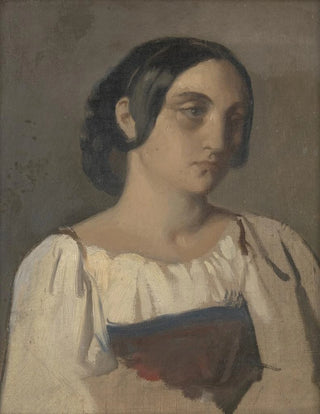Art print | Portrait of an Italian woman - Théodore Chassériau


View from behind

Frame (optional)
The "Portrait of an Italian Woman" by Théodore Chassériau is a work that transcends time, capturing not only the beauty of a face but also the essence of an era and a culture. This painting, created in the 19th century, evokes emotional depth and delicacy that touch the viewer. Contemplating this art print, one is immediately transported into Chassériau's artistic universe, where each brushstroke seems to tell a unique story. The woman depicted, both mysterious and charismatic, embodies a typically Italian beauty, while revealing stylistic influences that marked the art of her time.
Style and uniqueness of the work
Chassériau's style is distinguished by its ability to combine romanticism and classicism, creating a subtle balance between tradition and innovation. In "Portrait of an Italian Woman," the mastery of colors and shadows reveals an in-depth understanding of light, giving the composition an almost palpable atmosphere. The meticulous details of the face, hair, and clothing demonstrate particular attention to the representation of textures, while the intense gaze of the woman seems to invite the viewer to delve into her inner world. This art print does not merely depict a female figure; it evokes a story, an emotion, a life. The color palette chosen by the artist, with its warm nuances and delicate contrasts, helps create an intimate and captivating ambiance, making the work timeless.
The artist and his influence
Théodore Chassériau, born in 1819 in Le Havre, is one of the most influential painters of the French Romantic movement. A student of Jean-Auguste-Dominique Ingres, he developed a style that is uniquely his own, blending various influences ranging from neoclassicism to baroque art. Chassériau had a prolific career, creating numerous portraits and historical works that marked his era. His innovative approach to color and light paved the way for many artists who followed him. Through his portraits, he was able to capture not only the physical appearance of his subjects but also their soul, their character.

Matte finish

View from behind

Frame (optional)
The "Portrait of an Italian Woman" by Théodore Chassériau is a work that transcends time, capturing not only the beauty of a face but also the essence of an era and a culture. This painting, created in the 19th century, evokes emotional depth and delicacy that touch the viewer. Contemplating this art print, one is immediately transported into Chassériau's artistic universe, where each brushstroke seems to tell a unique story. The woman depicted, both mysterious and charismatic, embodies a typically Italian beauty, while revealing stylistic influences that marked the art of her time.
Style and uniqueness of the work
Chassériau's style is distinguished by its ability to combine romanticism and classicism, creating a subtle balance between tradition and innovation. In "Portrait of an Italian Woman," the mastery of colors and shadows reveals an in-depth understanding of light, giving the composition an almost palpable atmosphere. The meticulous details of the face, hair, and clothing demonstrate particular attention to the representation of textures, while the intense gaze of the woman seems to invite the viewer to delve into her inner world. This art print does not merely depict a female figure; it evokes a story, an emotion, a life. The color palette chosen by the artist, with its warm nuances and delicate contrasts, helps create an intimate and captivating ambiance, making the work timeless.
The artist and his influence
Théodore Chassériau, born in 1819 in Le Havre, is one of the most influential painters of the French Romantic movement. A student of Jean-Auguste-Dominique Ingres, he developed a style that is uniquely his own, blending various influences ranging from neoclassicism to baroque art. Chassériau had a prolific career, creating numerous portraits and historical works that marked his era. His innovative approach to color and light paved the way for many artists who followed him. Through his portraits, he was able to capture not only the physical appearance of his subjects but also their soul, their character.






